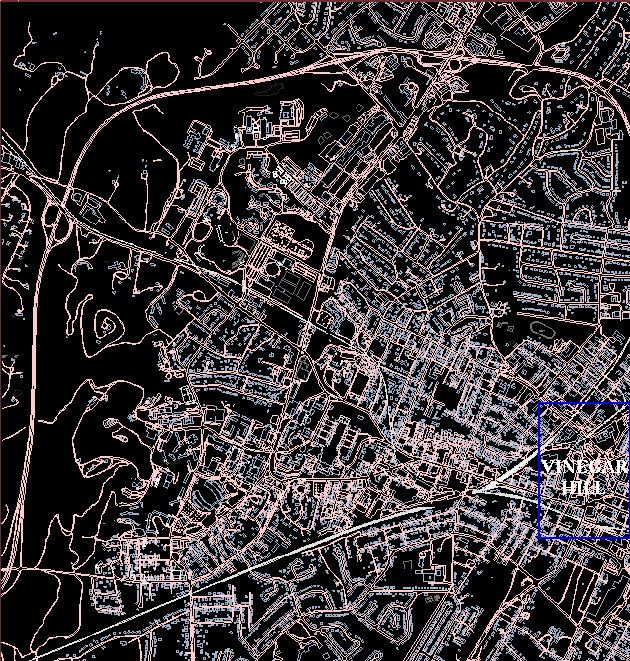

|
| History of Charlottesville |
| Graphic Analysis |
| Neighborhoods |
| Context Map |
| Charlottesville Archive |
| Feedback |
One of the most pressing problems confronting architects and planners involves the erosion of urban fabric in American cities and small towns. Many factors have contributed to the physical and economic decline of previously healthy cities since the end of World War II. Federal tax policies involving home mortgage deduction, FHA loan programs, and highway policy and subsidies have all conspired to promote suburban sprawl and a concurrent abandonment of city centers by the middle class. Nowhere has the impact of this problem been felt more seriously than in the area of housing.1 The legacy of the late 1950's and 1960's "urban renewal" has decimated vast tracts of land. In many areas of many cities, lower and middle income housing stock has been eliminated, often leaving a wasteland of parking in its place.
This research project addresses the specific context of Charlottesville, Virginia as a town that demonstrates many of the results of urban decay found in cities throughout North America. Through the vehicle of analysis and design, this project explores the application of sensible and traditional principles of town planning to various neglected or ruined areas of the city.2 The process of understanding a particular area of a small town requires an appreciation for the regional and historical forces that have produced the contemporary urban condition. In addition to the preliminary research and analysis, specific design proposals are explored for a series of "infill" areas that are currently abandoned, underdeveloped or largely neglected. These areas include the abandoned tracks of the so-called "CSX property" and its associated Belmont neighborhood, the Vinegar Hill neighborhood, the Starr Hill neighborhood, and the area surrounding the University of Virginia Hospital. All four of these areas include primarily low-income housing with predominantly African-American populations and students in the vicinity of the University. In many respects, the four indicated areas of Charlottesville are emblematic of similar challenges that can be found in many small towns. In this sense, research into traditional town planning principles and their application to this specific setting can lead to lessons that may be applied prototypically in other settings as well. Each area of study includes low and moderate income residents and housing with the potential for a clear localized sense of community within the larger city of Charlottesville; there are several important differences among the areas as well, principally in terms of topographic conditions and the proximity to various pressures on development in their immediately surrounding area.
The successful revitalization of these areas depends on an effective integration of multiple uses within a neighborhood setting. The most important aspect of any healthy urban fabric is the housing stock. As an independent but closely related second stage of this research project, we will explore detailed development of affordable housing strategies for these areas. To revive small towns, one must identify strategies for building both economically and with concern for traditions and patterns of life that characterize the best of small town settings. In this research, previous efforts with affordable housing strategies are explored, including both design principles and constructional considerations. In addition to the work of graphically codifying the available information and existing research in this area, the design work concentrates on assembly guidelines and standardization to generate economies of scale and efficiency in the production of housing prototypes. Typological and vernacular study of evolved traditions in housing can help in forming the basis for a return to more sensible and sensitive small town urbanism. Within this study, we are particularly interested in the possibility of using the strong housing traditions of Charlottesville and the surrounding region as the basis for proposals that try to reconcile these precedents with modern methods of assembly and construction.
New town planning proposals from a variety of contemporary practitioners and theorists have provided effective and convincing alternatives to the automobile oriented culture of suburban highway strip development.3 However, most of these projects, and their specific architectural elaboration, have been directed toward an upper end, relatively high-income housing market; they have not, for the most part, addressed lower and middle income housing. As architects, we must respond to the challenges of building within contemporary society with conviction about the efficacy of design in ameliorating some of the problems that affect cities. But we should also be wary of easy formulas in housing that can be appropriated and quickly consumed. To put these concerns in another perspective, a return to fundamental principles of pre-W.W.II town planning prevalent throughout the United States and Great Britain need not produce a simultaneous nostalgia about an architecture of pure historical quotation. Rather, housing must begin to address fundamental shifts in the way that it is produced, various approaches to the needs of different "clients" must be considered and a wide range of delivery systems and applications should be proposed. This project combines and reconciles traditional town planning principles with essential concerns about modest and low cost housing.
| Methodology | Specific Uses of Information Technology | Notes Regarding the Application of this Research | Introduction Notes |
 Charlottesville Archive
Charlottesville Archive
| Acknowledgements | Bibliography | Make a suggestion |
 IATH WWW
Server
IATH WWW
Server